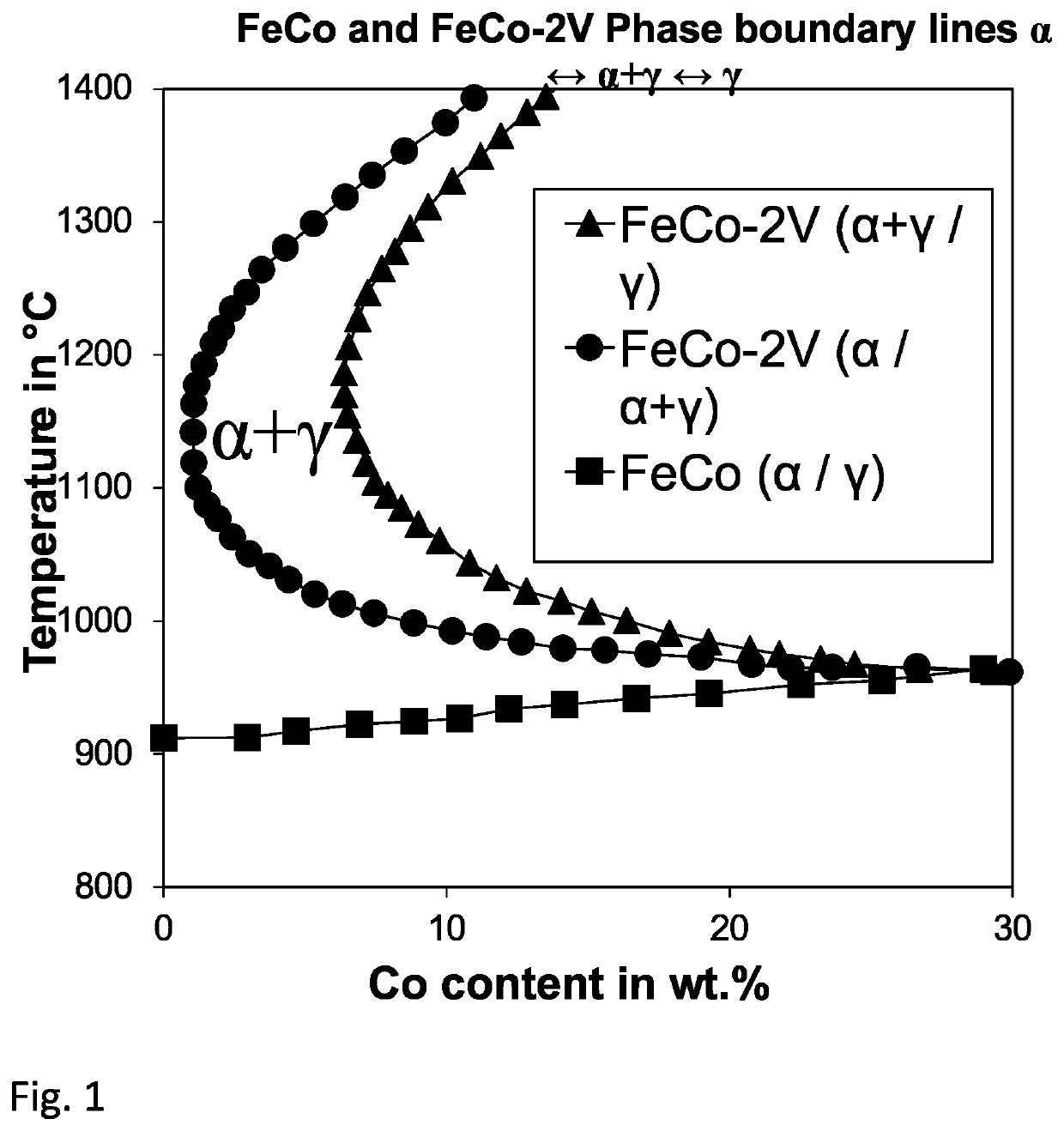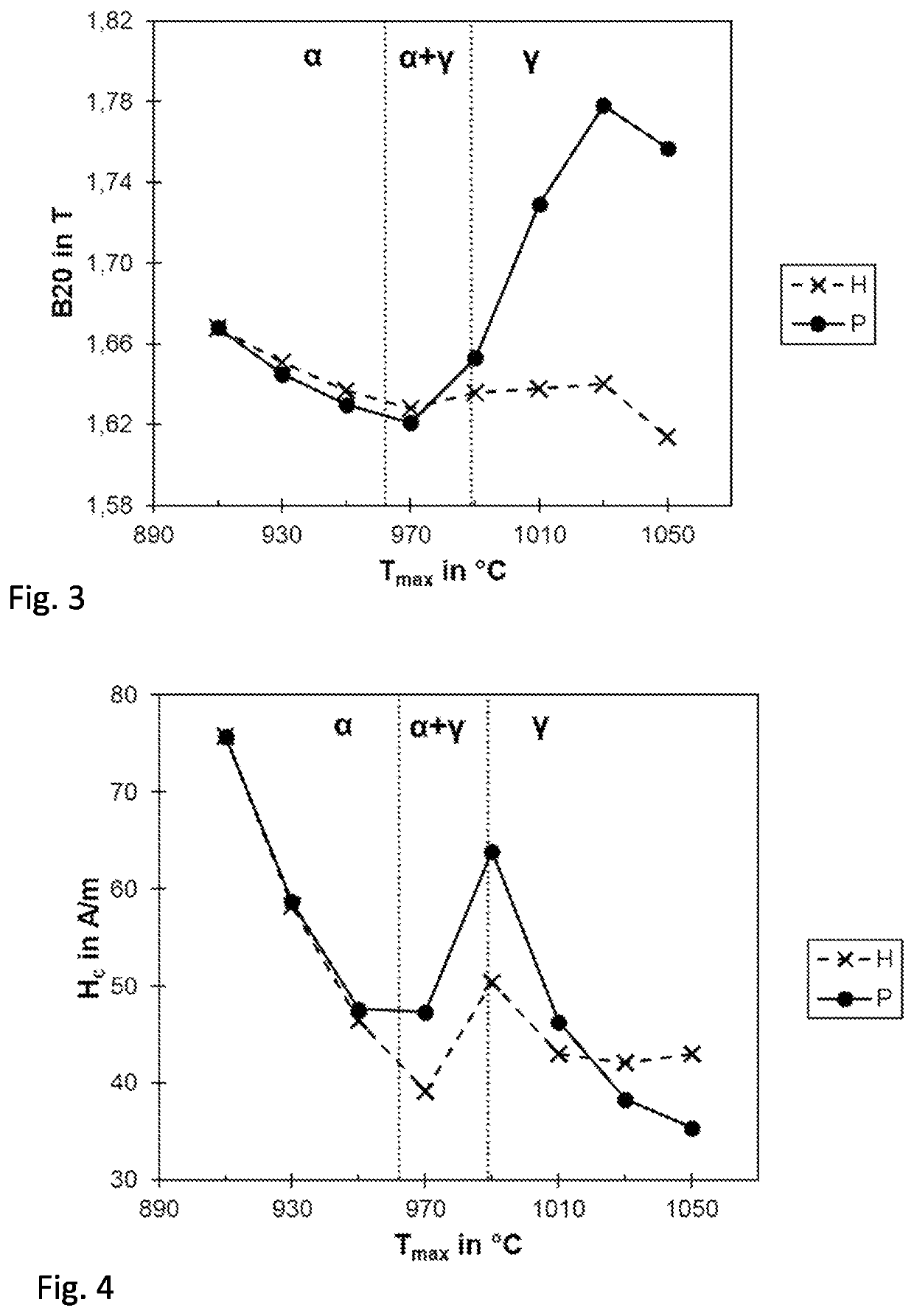Soft magnetic alloy and method for producing a soft magnetic alloy
a soft magnetic alloy and magnetic alloy technology, applied in the direction of inorganic material magnetism, superimposed coating process, coating, etc., can solve the problems of affecting the magnetic properties of ceramic powder alone, affecting the production of industrial-scale commercial ceramic powder, and affecting the magnetic properties of ceramic powder, etc., to achieve good magnetic properties, reduce co content, and produce more reliably
- Summary
- Abstract
- Description
- Claims
- Application Information
AI Technical Summary
Benefits of technology
Problems solved by technology
Method used
Image
Examples
example c2
[0211 corresponds to sample A3 as explained above, which was annealed in Ar in the heating phase. The partial use of Ar results in very good magnetic values. The downstream heat treatment in the α-region, as shown for example C2′, leads to a further clear drop in Hc to 29.2 A / m and a clear increase in maximum permeability to 20,238.
[0212]Examples C3 and C3′ show the influence of second heat treatment process on a sample that had been annealed in nitrogen in the first heat treatment process in the heating phase. All the magnetic parameters listed improve slightly, with maximum permeability remaining relatively low at 7747 and coercive field strength remaining relatively high at 77.1 A / m even after this heat treatment.
[0213]Reference example C4 not according to the invention was annealed in nitrogen alone during the first heat treatment process. It proved impossible to achieve the magnetic parameters required by dispensing with hydrogen, and the long presence of nitrogen during anneal...
example e
[0225 represents the uncoated reference sample. Annealing results in very good soft magnetic properties. The very high induction B20 of 1.77 T, in particular, is an indicator of a very high cube face texture (001)[uvw] fraction, which is successfully formed by the annealing in the γ-region. The advantageous orientation also results in a very high maximum permeability of almost 13,000 and a low coercive field strength Hc of only 37.3 A / m.
example f
[0226]In example F the strip was provided with a zirconium propylate coating on both sides before punching. During annealing this transforms into surface zirconium oxide. This dense covering suppressed the formation of the cube face texture, resulting in an induction B20 of just 1.687 T. At Hc 46.4 A / m, coercive field strength is also clearly above the value of reference sample E.
[0227]To permit the formation of the cube face texture while still achieving sufficient separation of the sheets during annealing, it is nevertheless possible to use one of the aforementioned coatings (DL1 or HITCOAT) as long as it is sufficiently thin and as long as the coating is applied to one side of the strip only.
[0228]In example G the strip was first coated in the normal way, i.e. on both sides, and then the coating was chemically removed from one side using a solvent. The exposed side was then recoated with a highly diluted coating solution such that one side only of the strip was coated in the norm...
PUM
| Property | Measurement | Unit |
|---|---|---|
| Temperature | aaaaa | aaaaa |
| Temperature | aaaaa | aaaaa |
| Fraction | aaaaa | aaaaa |
Abstract
Description
Claims
Application Information
 Login to View More
Login to View More - R&D
- Intellectual Property
- Life Sciences
- Materials
- Tech Scout
- Unparalleled Data Quality
- Higher Quality Content
- 60% Fewer Hallucinations
Browse by: Latest US Patents, China's latest patents, Technical Efficacy Thesaurus, Application Domain, Technology Topic, Popular Technical Reports.
© 2025 PatSnap. All rights reserved.Legal|Privacy policy|Modern Slavery Act Transparency Statement|Sitemap|About US| Contact US: help@patsnap.com



